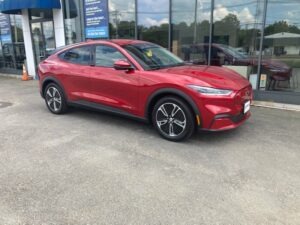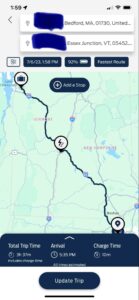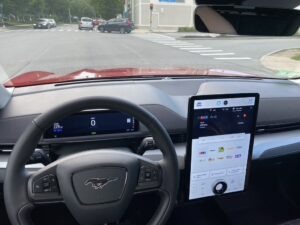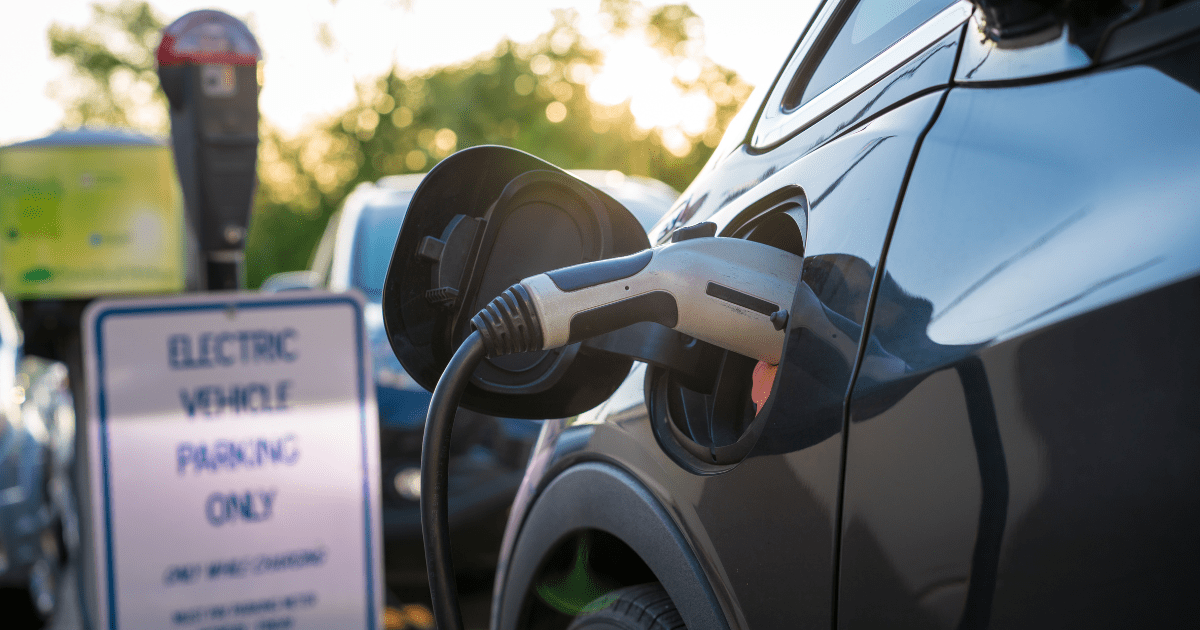
Over 4th of July this year, I made a trip from the Boston suburbs to a small city in Vermont, in my electric vehicle (EV) that duplicated the same route and the same stops as a trip over Thanksgiving 2022. The comparisons are illuminating!
I’ve owned my 2022 Ford Mustang Mach-E for almost exactly a year now, which seems like a good time to assess some of what I’ve learned as an EV owner in that first year.
Trip 1: 2022
Last Thanksgiving, my husband and I decided to let a culinary spa and resort in northern Vermont take care of our Thanksgiving meal, rather than cooking for two. We decided to test the range of our Mach-E on this trip.
As a baseline, we regularly charge the car on our 240-volt Ford charger, installed in our garage. Under normal conditions at 100% charge, the range sits at about 225 miles. The trip is technically 205 miles each way, but hilly terrain, cold weather, and using the climate and navigation systems all reduce that.
We used the FordPass app’s trip planning feature to plan the route, which incorporates charging stations and charging duration into the navigation guidance.
When we arrived at an Electrify America charging station next to a Walmart in West Lebanon, NH, we had a little under 100 miles of range left after an hour and a half of driving. The station was easy to spot in the parking lot, and there were 4 individual towers with plugs on each side — theoretically, 8 cars could be charging at once.
We pulled into the fourth parking space but immediately saw that the tower was out of service. It wasn’t obvious what the issue was, but other drivers who were hanging around called out “that one’s not working!” That also caused us to realize we had jumped the line: there were at least 2 other EVs waiting for charging spots. And although the towers are equipped with a plug on each side, the parking spaces are arranged such that only one side is usable at a time. So despite the potential for up to 8 cars to charge, only 3 could.
Use en route charging station locator apps

After 30 minutes of charging, we were at 80% battery (about 180 miles), which is the recommended stopping point when traveling because charging speeds drop after that point. Overall, we were stopped for about an hour, then made it to our final destination just below 100 miles of range. During our stay, we charged up at local stations.
We had a 95% charge when we started home. Once again, the Walmart Electrify America station was the suggested stopping point, but there were at least 5 cars waiting to charge when we arrived. Plus the fourth tower remained out of service. We set off to find some other place to charge.
Using the PlugShare app we encountered problem after problem chasing after chargers all over southeastern Vermont and southwestern New Hampshire. We would locate a charger only to find when we got there that it was a trickle charge and would take hours or that it was on commercial property and felt like trespassing (even if it wasn’t). All the running around burned up miles, and we were down to about 75 miles of range before locating a fast charger. We spent a half hour getting back to 80% charge. However, after encountering holiday traffic and back road reroutes, we required an unplanned stop at a trickle charger about 20 miles from home.
I kept holiday traffic reroutes and busy charging stations in mind when I prepared to take one of my kids to a sleepaway camp in Vermont, staying at the same culinary resort for a few days around this July 4th.
Trip 2: 2023
This year’s trip was a much different experience. When we arrived at the West Lebanon, NH, Walmart parking lot, there was no wait and all 4 towers appeared to be working. We plugged in and walked down the street to have dinner, knowing that when we got back the car would be charged. Sure enough, an hour later it was at 100%, and we went on our way. Driving home on 4th of July, though, I was sure we would encounter far more traffic and demand for charging. And we did: coming back to Massachusetts, we found all the stations at the West Lebanon Walmart occupied and several vehicles waiting to charge.
Luckily, I noticed PlugShare now offers a check-in feature within the app. I could see, for example, that one other person had used the app to say they were waiting and that they’d been there for 20 minutes. I could also check in myself, indicating how long I was willing to wait. Not all drivers use PlugShare, though. If they do, nothing compels them to check in as the check-in feature doesn’t actually reserve a spot in line or designate who has dibs on the next open charger. The context of which drivers are waiting, how long they’ve been there, and in what order they arrived is helpful to determine if you’ll wait too.
New updates to charging station locator apps
 It was hot, and we were anxious to get home, so I decided to check whether there were any other charging stations nearby. Lo and behold, a ChargePoint station in White River Junction, VT, that certainly had not shown up back in November 2022 now showed up on the PlugShare map only 2.8 miles away. PlugShare now also noted that it was a fast charge station with an average speed of 72 kWh, more information that had not been available in their app eight months ago. We zipped over to that station, which was totally unoccupied: plugged in at 80 miles range, charged for 24 minutes, and disconnected at 155 miles range with 118 miles to home. Easy, peasy.
It was hot, and we were anxious to get home, so I decided to check whether there were any other charging stations nearby. Lo and behold, a ChargePoint station in White River Junction, VT, that certainly had not shown up back in November 2022 now showed up on the PlugShare map only 2.8 miles away. PlugShare now also noted that it was a fast charge station with an average speed of 72 kWh, more information that had not been available in their app eight months ago. We zipped over to that station, which was totally unoccupied: plugged in at 80 miles range, charged for 24 minutes, and disconnected at 155 miles range with 118 miles to home. Easy, peasy.
Electric vehicle charging is only improving
The dramatic improvements to EV charging in only eight months are extremely encouraging: more stations are being installed daily across the country, apps for finding stations are improving and adding features, and highway signage is starting to incorporate charging locations).
Plus, this is only the beginning: the National Electric Vehicle Infrastructure (NEVI) bill that made $7.5 billion available for EV charging station rollouts along interstate corridors has started to be implemented. The bill requires that charging stations be installed along interstates no more than 50 miles apart, that they be located within 1 mile from the highway exit, and that they be working at least 97% of the time.




